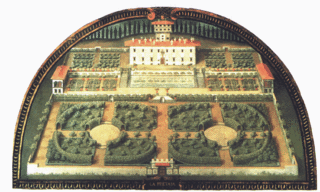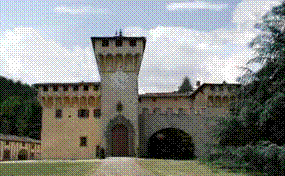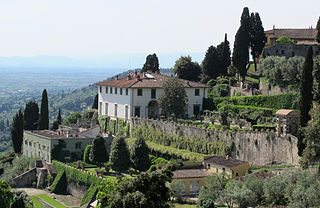
The Accademia di Belle Arti di Firenze is an instructional art academy in Florence, in Tuscany, in central Italy.

The Squarcialupi Codex is an illuminated manuscript compiled in Florence in the early 15th century. It is the single largest primary source of music of the 14th-century Italian Trecento.

Villa del Poggio Imperiale is a predominantly neoclassical former grand ducal villa in Arcetri, just to the south of Florence in Tuscany, Central Italy. Beginning as a villa of the Baroncelli of Florence, it was seized by the Medici, became the home of a Medici princess, and a lavish retreat for a Grand Duchess with imperial pretensions. Later given to Napoleon's sister, it was reclaimed by the hereditary rulers of Tuscany before being finally converted to a prestigious girls' school. During its long history, it has often been at the centre of Italy's turbulent history, and has been rebuilt and redesigned many times.

The Albizzi family was a Florentine family originally based in Arezzo, who were rivals of the Medici and Alberti families. They were at the centre of Florentine oligarchy from 1382, in the reaction that followed the Ciompi revolt, to the rise of the Medici in 1434. They were active members of the Arte della Lana, Florence's wool guild. The Guilds played a central role in the governance of the Republic of Florence during the medieval period and guild members constituted Florence's political and economic oligarchy.

Niccolò di Raffaello di Niccolò dei Pericoli, called "Il Tribolo" was an Italian Mannerist artist in the service of Cosimo I de' Medici in his natal city of Florence.

Monsummano Terme is an comune located in the Province of Pistoia, Tuscany, central Italy. It is located in the Valdinievole, and is a popular spa resort.

The Villa Medici at Careggi is a patrician villa in the hills near Florence, Tuscany, central Italy.

Giusto Utens or Justus Utens was a Flemish painter who is remembered for the series of Medicean villas in lunette form that he painted for the third Grand Duke of Tuscany, Ferdinando I, in 1599–1602.

The Villa Medicea di Cafaggiolo is a villa situated near the Tuscan town of Barberino di Mugello in the valley of the River Sieve, some 25 kilometres north of Florence, central Italy. It was one of the oldest and most favoured of the Medici family estates, having been in the possession of the family since the 14th century, when it was owned by Averardo de' Medici. Averardo's son, Giovanni di Bicci de' Medici, is considered to be the founder of the Medici dynasty.

The Villa di Pratolino was a Renaissance patrician villa in Vaglia, Tuscany, Italy. It was mostly demolished in 1822. Its remains are now part of the Villa Demidoff, 12 km north of Florence, reached from the main road to Bologna.

The Medici villas are a series of rural building complexes in Tuscany which were owned by members of the Medici family between the 15th century and the 17th century. The villas served several functions: they were the country palaces of the Medici, scattered over the territory that they ruled, demonstrating their power and wealth. They were also recreational resorts for the leisure and pleasure of their owners; and, more prosaically, they were the centre of agricultural activities on the surrounding estates. In 2013, the Medici villas were added to UNESCO's World Heritage list.

The Villa di Castello, near the hills bordering Florence, Tuscany, central Italy, was the country residence of Cosimo I de' Medici, Grand Duke of Tuscany (1519-1574). The gardens, filled with fountains, statuary, and a grotto, became famous throughout Europe. The villa also housed some of the great art treasures of Florence, including Sandro Botticelli's Renaissance masterpieces The Birth of Venus and Primavera. The gardens of the Villa had a profound influence upon the design of the Italian Renaissance garden and the later French formal garden.

The Villa del Trebbio is a Medici villa in San Piero a Sieve, Tuscany, Italy.

Villa il Gioiello is a villa in Florence, central Italy, famous for being one of the residences of Galileo Galilei, which he lived in from 1631 until his death in 1642. It is also known as Villa Galileo.

The Italian Renaissance garden was a new style of garden which emerged in the late 15th century at villas in Rome and Florence, inspired by classical ideals of order and beauty, and intended for the pleasure of the view of the garden and the landscape beyond, for contemplation, and for the enjoyment of the sights, sounds and smells of the garden itself.

The Villa di Montevettolini is a Medici villa in the comune of Monsummano Terme, Tuscany, central Italy.

Museo di Firenze com'era was a history and archaeology museum, one of the civic museums of the city of Florence.

The Villa di Marignolle is a Medici villa in the hills between Galluzzo and Soffiano, in the south-western suburbs of the comune of Florence, in Tuscany in central Italy. It passed into the hands of the Medici family after the Pucci Conspiracy, when it was confiscated from Lorenzo di Piero Ridolfi by Francesco I de' Medici, Grand Duke of Tuscany. Francesco passed it to his illegitimate son Antonio.

The Medici Villa of Poggio a Caiano, also called Ambra, is one of the most famous Medici villas and is located in Poggio a Caiano (Prato). Today it is state owned and it houses two museums: one of the historic apartments and the Museum of Still Life.

Villa Corsini a Castello is a suburban villa near Florence, Italy, located in via della Petraia.
























